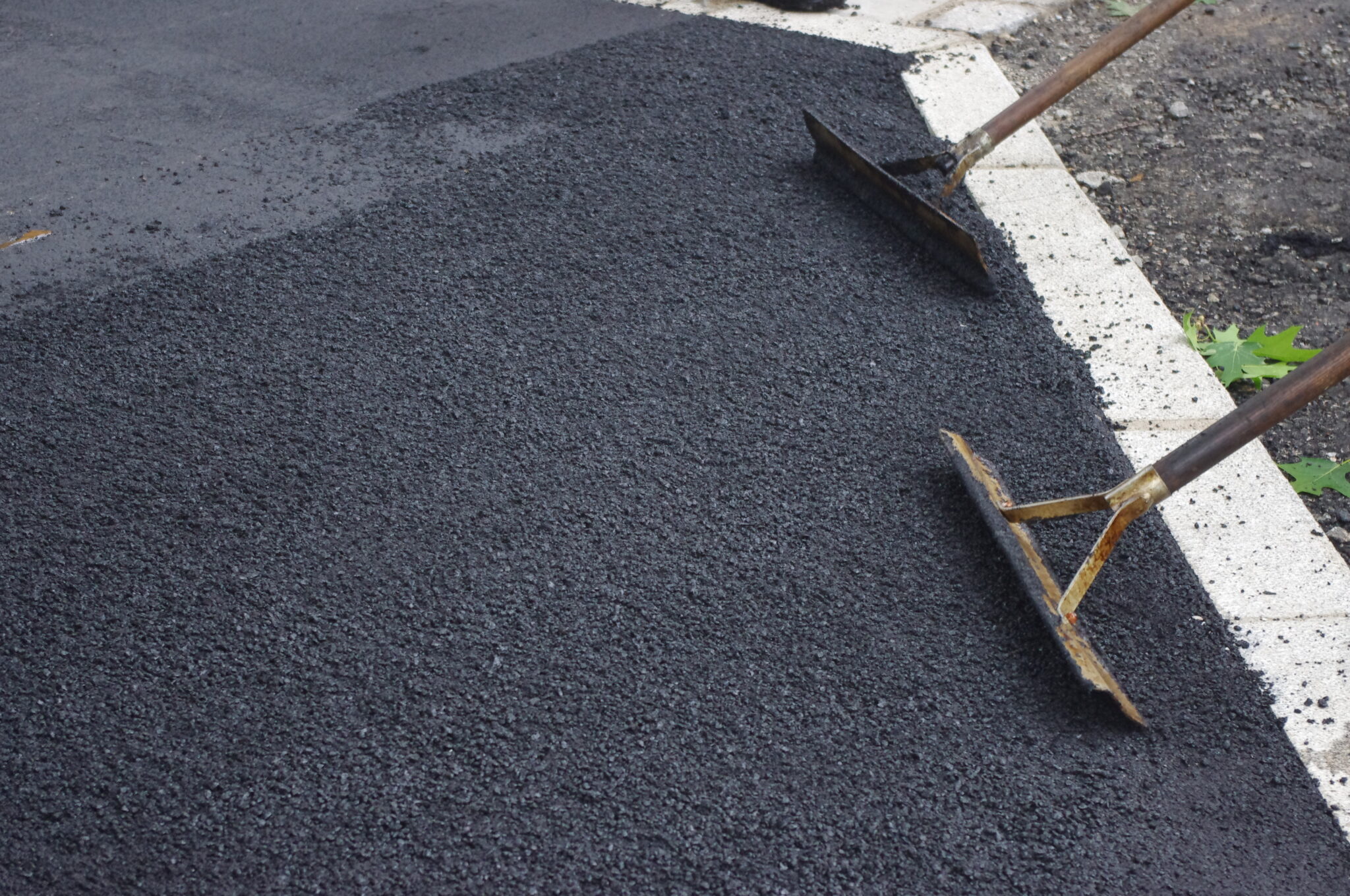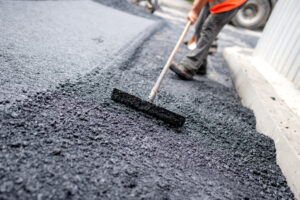If you’ve ever looked into driveway paving or road surfacing, you’ve probably stumbled upon the age-old question: tarmac vs asphalt. What’s the difference, and which one should you choose? While the two terms are often used interchangeably, they’re not quite the same. In fact, understanding the subtle (and not-so-subtle) differences between tarmac and asphalt can help you make smarter decisions about your property, save money, and avoid unnecessary repairs down the line. In this blog, we’ll break down everything you need to know – from composition and performance to cost, lifespan, and ideal use cases.
Tarmac and Asphalt Explained
What Is Tarmac?
Tarmac, short for tarmacadam, is a pavement material invented by Edgar Purnell Hooley in the early 1900s as an improvement on traditional macadam roads. It’s made by combining crushed stone or aggregate with tar, a sticky black substance derived from coal. The mixture is then laid down and compacted with a steamroller. Tarmac gained popularity for its binding strength and smooth surface.
Although tarmac is still referenced today, actual tar-based surfaces are rarely used in modern construction due to environmental and safety concerns. In fact, most people referring to “tarmac” are actually talking about asphalt.
What Is Asphalt?
Asphalt is a newer, more advanced paving material made from aggregates and bitumen. Unlike tarmac, it uses bitumen as a binder, which is a petroleum byproduct and far less toxic than coal-tar binder. It also performs much better under stress, making it the go-to material for highways, driveways, airport runways, and parking lots. Additionally, asphalt is more adaptable to different climates and easier to recycle than traditional tar-based materials.
Overall, asphalt is the modern-day leader for pavements across the world. It can weather frequent traffic and provide improved sustainability over older tar-based surfaces. That being said, the environmental impact isn’t the only difference between tarmac and asphalt, as we’ll go over more in-depth in the next section.
What Are the Main Differences Between Asphalt and Tar?
Despite their similar appearances and modern interchangeability, tarmac and asphalt have several key differences. Below we’ve put together a brief table of the most important distinguishing factors:
| Feature | Tarmac | Asphalt |
| Composition | Uses tar as the binding agent, which is derived from coal. | Uses bitumen, a more refined and stable petroleum product. The binder is stronger and more flexible |
| Smell | Strong, acrid smell, especially when heated | Milder, petroleum-like smell; far less offensive during application |
| Color | Blacker and glossier appearance | Grayer and more matte appearance once laid and cured |
| Texture | Rougher and more brittle, especially in cold weather | Smoother and denser; offers a quieter, more comfortable driving experience |
| Toxicity | Emits harmful VOCs; more toxic and hazardous to workers and the environment | Less toxic; and safer to produce, install, and maintain. |
| Climate Behavior | Struggles in extreme temperatures — softens in heat, cracks in cold | Holds up well in both hot and cold climates. Modern formulas can be tailored for specific regional performance |
From these differences, it’s clear why asphalt is used much more often than tarmac, offering a cleaner manufacturing process and end result. If you’re still not convinced, in the next section we go over the pros and cons of each pavement material, considering cost, installation, durability, and more.
Which Material Is Better for Roads and Driveways
Asphalt roads and driveways are much more common than tarmac. In this section, we’ll go over exactly why.
Tarmac
Tarmac used to be the popular choice for property owners due to its convenience and improvements from older materials. In the modern day, however, its drawbacks make it less viable for construction. Here are some of tarmac’s pros and cons:
Pros:
- Cheaper to produce in older systems
- Quick installation
- Provides good traction from its coarse texture
Cons:
- Environmental concerns that make it rarely used today
- More prone to weather damage and cracking
- Limited availability of materials and experienced contractors
Tarmac is sometimes still used in specialized applications or heritage projects. For the average homeowner or city planner though, it’s mostly outdated.
Asphalt
Asphalt, on the other hand, is much more prevalent in society today, covering millions of miles worth of pavement. Here are its main pros and cons:
Pros:
- Durable and long-lasting (with proper maintenance)
- Weather-resistant and flexible
- Safer and more environmentally friendly than tar
- Easy to patch and maintain
- Widely available and supported by modern equipment
Cons:
- Slightly more expensive upfront than tar (but cheaper over the long term)
- Can develop surface oxidation over time if not sealed
In short, asphalt wins in almost every category, especially when it comes to longevity, safety, and versatility.
Asphalt vs Tarmac Cost
Cost is always a major consideration in any paving project, so let’s break it down.
Tarmac: Tarmac used to be a cheaper option when coal tar was abundant. Since it’s rarely produced and not widely supported, it can be more expensive and harder to source today.
Asphalt: Despite slightly higher upfront material costs, asphalt benefits from economies of scale, modern infrastructure, and widespread availability.
On average:
- Asphalt driveway installation can range from $3 to $7 per square foot
- Tarmac, if even available, may cost more due to special handling or sourcing, but it depends on the application.
Factor in maintenance, and asphalt becomes even more cost-effective. It’s easier to reseal, patch, and recycle, meaning you’ll save on driveway repairs and replacement down the line.
Choosing the Right Material for Your Project
Choosing the right material isn’t as simple as picking the most popular option; there are key specifications to consider for each individual project.
Residential Driveways
Unless you’re restoring a historic property with original tarmac, asphalt or concrete driveways are the smarter choice. They offer smoother finishes, better curb appeal, and long-term value.
Roads and Highways
Tarmac hasn’t been used in major roadway construction for decades. Asphalt dominates the industry due to its proven performance under heavy traffic and extreme weather.
Airports and Industrial Surfaces
While people still call airport runways “the tarmac,” what they’re really seeing is asphalt or concrete. Again, asphalt wins for flexibility, load-bearing capacity, and ease of maintenance.
Rural or Temporary Applications
Tarmac might occasionally pop up in temporary rural roads or small private lanes, but even then, it’s usually replaced quickly by asphalt-based solutions or gravel depending on budget.
It can be difficult to choose a material for a paving project when there’s so many options. If you feel conflicted, don’t be afraid to contact a professional to seek advice.
Hire Superior Asphalt for High-Quality Asphalt Maintenance & Repairs
Now that you know the real difference between tarmac and asphalt, you can feel confident in selecting the right material for your next project. While tarmac may have had its heyday in earlier road construction, asphalt remains the top choice for modern paving thanks to its durability, flexibility, and overall performance. Whether you’re planning a new installation or looking to maintain existing pavement, it pays to work with professionals who understand every layer of the process. Superior Asphalt is Utah’s go-to expert for asphalt maintenance and repairs. We bring decades of experience, top-quality materials, and a commitment to getting the job done right. Contact us today for a customized quote.


